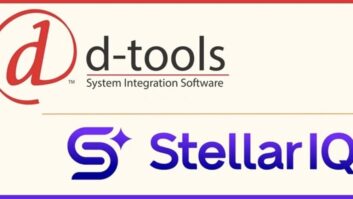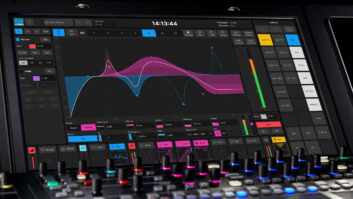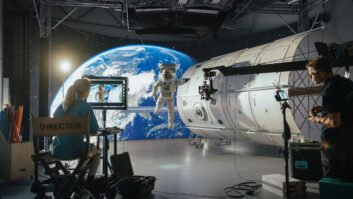There has been a significant expansion in the number and variety of presentation tools in recent years, but it can be hard to ascertain which features are really driving those all-important purchasing decisions. With a view to finding out which aspects are essential and which are viewed as ‘nice to haves’, Installation resolved to examine the landscape in two key markets: corporate and education.
With the assistance of leading players in the field, we were able to establish the current nature of demand in both markets; the particular impact of tighter budgets on investment by education customers; and the extent to which emerging technologies – including AI – are beginning to have an impact on this area of solutions.

DIGITAL TRANSFORMATION
Dennis Lin is general manager of the presentation group at ViewSonic, whose latest developments in enterprise include the ability of ViewBoard interactive displays to serve as hubs, with AI-enhanced workflows paired with software such as ViewSonic’s TeamOne for collaborative, web-based canvases and AirSync for secure, multi-device content sharing.
Meanwhile, in education, the company has launched myViewBoard 3.0, which features an intuitive interface with multi-tab lesson planning and AI tools, such as voice-to-text and live translation, to streamline teaching.
Lin says: “Across both corporate and education markets, the demand for new presentation tools is being driven by three common forces: ongoing digital transformation, rising expectations for engagement, and the shift toward flexible, connected and adaptable systems to different usage scenarios.
“In the corporate sector, the move from static displays to interactive, intelligent hubs is accelerating. Organisations want solutions that enhance visual communication, integrate seamlessly with hybrid work models, and support AI-powered functions and sensor-based technologies. Cross-device connectivity and interoperability have become essential for smooth integration across platforms. Then in education, adoption is growing as schools aim to create more interactive learning environments. Interactive displays with built-in whiteboarding are becoming standard, supporting both in-person and hybrid teaching.”
Inevitably, financial pressures are more prominent in education, where budgets have recently declined in real-terms in many territories, including in the EU.
Michael Strand is chief revenue officer of Promethean Group, whose latest launches include the ActivPanel 10 interactive display designed to support both education and corporate environments: “Educational institutions are evaluating their investments more critically. They are focusing on solutions that can show real impact – particularly in terms of engagement, adaptability to different learning styles, and seamless integration with platforms such as Google Workspace and Microsoft 365. Schools also want to ensure they are prepared for any future disruptions. Flexibility and future-readiness have become key priorities.”
Like Lin, Strand highlights the onward march of hybridisation as a key purchasing driver in the corporate market. “Hybrid work is driving demand for tools that connect remote and in-room participants effectively,” he says. “Organisations want solutions that enable fast, collaborative decision-making and support a wide range of content formats. However, many are still discovering the full value of interactive displays and collaborative technologies. Adoption is often strongest among younger teams, who already know these tools from their education experience and expect similar functionality in the workplace.”

MARKET MUST-HAVES
So what of the ‘must-have’ features across both markets? Across the responses, there is no doubt that providing an intuitive interface requiring a minimum of training is widely perceived as sacrosanct (“this ensures users can get started quickly without a steep learning curve,” notes Strand). Beyond that, built-in whiteboarding, annotation tools and reliable wireless casting – ensuring that tools can work across laptops, tablets and smartphones on any operating system – are features cited by Strand, and echoed elsewhere.
Strand adds: “Integration with widely used collaboration platforms such as Microsoft Teams, Zoom and Google Meet is critical. Robust security and user management are equally important to protect data and control access. Finally, high-quality audio and video are seen as indispensable for maintaining audience engagement.”
Jonathan Owen is solution architect of Wolfvision, which has recently added a new ‘splash screen’ to its Cynap family designed to make it easier to utilise BYOM functionality. He says: “The true measure of a successful AV system lies in its ability to mask complexity with intuitive, streamlined experiences. As functionality grows, so too must our commitment to making these powerful tools accessible and straightforward. When done right, users focus on what they want to achieve, not on how to operate the technology. In an age where features can be endless, keeping the user journey simple isn’t just good design, it’s essential.”
There is also an acute awareness that presentation tools must be able to fit into existing configurations. Lutz Harder, global product manager – interactive displays at PPDS, says: “Whether for the AV/IT manager, or for the users of the displays and the presentation tools, making them an easy fit into existing infrastructures and knowledge bases is essential. In our time-poor world, we don’t want to read an instruction manual before using a presentation tool, nor do we want every presenter to have to download a new app, or even to have to find the right wires.”
To this end, one of PPDS’ recent launches is the Philips ScreenShare wireless content sharing system, which adopts a “tech-agnostic approach” that supports content sharing from any device, connected to any network (LAN, WiFi, mobile) and running on any operating system. This includes devices on Windows, Mac, iOS, iPadOS, ChromeOS, or Android, with AirPlay, Google Cast, and Miracast also supported.
EXPERIENCE ENHANCERS
Alongside the must-haves, there are also ‘nice to have’ elements that can enhance the overall experience. “More advanced whiteboarding and annotation capabilities fall into this category, particularly in educational settings,” says Strand. “Accessibility tools, such as live captioning and screen readers, are also welcome additions. [Additionally] some customers value the ability to customise templates, content and branding so they align with their organisation’s identity. Integrated room booking systems or environmental controls can add convenience. AI-driven features like content suggestions or automatic layout adjustments are also attracting interest, although they are not yet considered critical by most buyers.”
Anneke Hart is business development manager at LG, whose LG Information Display range includes a number of advanced presentation and signage solutions tailored for corporate environments, including the upgraded LG MAGNIT Micro LED. Among features regarded as “nice-to-have” are those which add engagement value for presentations, events and lobbies – such as touch interactivity, gesture recognition, and QR-enabled personalisation (as seen in LG’s Kinetic LED installations).
Hart adds: “Also, front-access module adjustments, modular design, and reduced standby power consumptions make deployment and upkeep more cost-effective.”
Harder also cites a growing awareness of energy efficiency issues: “With rising power costs, and a growing emphasis on sustainability for businesses, the ability to easily power down and to control energy consumption by controlling aspects such as display brightness, can make a difference. Here, remote device management, such as Philips Wave [display management platform], is easy and intuitive for AV/IT managers, supporting savings in time, energy, and the fuel that may be used in moving from site to site for display maintenance.”
Meanwhile, Hart points to a broader industry shift in favour of a subscription-type model. There is, she says, “a rising market for subscription-based services”, to which LG is responding by providing flexible, service-oriented models that bundle devices with care and content services, allowing businesses to scale and adapt more easily. For example, LG’s Pro: Centric Cloud is a comprehensive management solution that allows remote management of digital signage, simplifying operations and reducing the need for on-site visits.”
AI TRANSFORMATION
But in terms of the developments that are set to have the greatest impact on presentation tools in the next few years, it will come as no surprise to discover that many of them pertain to AI – with real-time transcription, automatically created visual aids, and general inclusivity and accessibility among the expected benefits.

Harder says: “AI will continue to grow in relevance, and its integration will rise in prevalence in both hardware and software, enabling faster presentation creation, easier refinements to cater for the audience in the room, and easier follow ups and note taking.”
Strand asserts: “AI-enhanced presentation tools can reshape both education and corporate environments. Features such as real-time transcription, language translation, and AI-generated visual aids are helping presenters communicate more effectively and inclusively. In education, adaptive learning content is expected to grow in importance, with tools that respond to student interaction and adjust teaching in real-time to support diverse learning styles and needs. In corporate settings, deeper integration with workflow tools and analytics platforms will allow presenters to measure engagement, automate follow-ups, and refine content based on audience response.”
He adds “Accessibility is also becoming a core consideration. Features such as live captioning, screen reader compatibility, and voice control are no longer optional – they’re essential for ensuring presentations are inclusive and effective for all participants.”
For ViewSonic, Lin also foresees AI playing a major role in “transforming lesson delivery”. He says: “We see a future where AI supports teachers through end-to-end lesson preparation – from sourcing materials and structuring lesson plans to designing interactive activities – saving valuable time and allowing educators to focus on student engagement. AI will also enhance content quality, enable real-time multilingual translation, and adapt lessons to different cultural and learning contexts.”
In corporate environments, meanwhile, “we expect to see AI assistants embedded directly into meeting systems – helping plan agendas, summarise discussions in real-time, respond to voice commands, and coordinate across devices. AI will also drive integrated content orchestration, where inputs from voice, touch, and documents are combined into one seamless, interactive session”.
VR RISING
Aside from AI, there is an expectation that AR and VR will steadily play a larger role in classrooms and corporate facilities. For Wolfvision, Owen notes: “VR has really come into its own, and we’re seeing that first-hand with the Cynap projects we’re delivering. We’re working on everything from medical and manufacturing training to full-scale real-world simulations, and it’s incredible to see how immersive the learning experience can be.”
Final word to Hart, who suggests that the next cycle of innovation tools will be defined by “intelligence, immersion and interactivity”. In addition to the exploration of AI-enhanced signage that can adjust content dynamically, she predicts that “presentation tools will continue to increasingly integrate with cloud platforms, video conferencing and interactive whiteboards, creating unified ecosystems for hybrid teams. Touchscreens and gesture-based controls will become standard, allowing users to navigate, annotate and interact with content directly on the display”.
In short, she concludes: “The ‘next big things’ are not just about better visuals – they are also about smarter, more adaptive, and more human-centric presentation experiences.”







